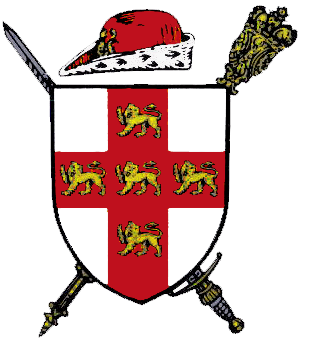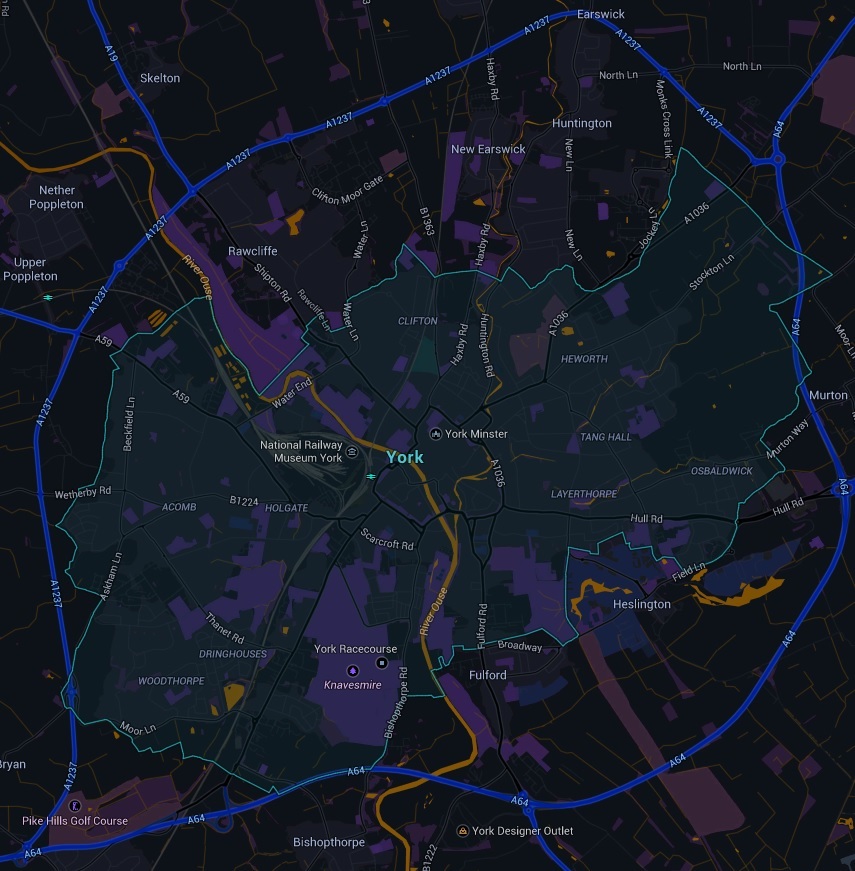Difference between revisions of "York"
(→Geography) |
(→History) |
||
| Line 37: | Line 37: | ||
== '''History''' == | == '''History''' == | ||
| − | + | === Introduction === | |
| + | The history of York as a city dates to the beginning of the first millennium AD but archaeological evidence for the presence of people in the region of York dates back much further to between 8000 and 7000 BC. As York was a town in Roman times, its Celtic name is recorded in Roman sources (as Eboracum and Eburacum); after 400, Anglo-Saxons took over the area and adapted the name by folk etymology to Old English Eoforwīc or Eoforīc, which means "wild-boar town" or "rich in wild-boar". The Vikings, who took over the area later, in turn adapted the name by folk etymology to Norse Jórvík meaning "horse bay." The modern Welsh name is Efrog. | ||
| − | + | After the Saxon settlement of the North of England, Anglian York was first capital of Deira and later Northumbria, and by the early 7th century, York was an important royal centre for the Northumbrian kings. Following the Norman Conquest of 1066 York was substantially damaged, but in time became an important urban centre as the administrative centre of the county of Yorkshire. York prospered during much of the later medieval era; the later years of the 14th and the earlier years of the 15th centuries were characterised by particular prosperity. During the English Civil War, the city was regarded as a Royalist stronghold and was besieged and eventually captured by Parliamentary forces under Lord Fairfax in 1644. After the war, York slowly regained its former pre-eminence in the North, and, by 1660, was the third-largest city in England after London and Norwich. | |
| + | |||
| + | Modern York has 34 Conservation Areas, 2,084 Listed buildings and 22 Scheduled Ancient Monuments in its care. Every year, thousands of tourists come to see the surviving medieval buildings, interspersed with Roman and Viking remains and Georgian architecture. | ||
== '''Location''' == | == '''Location''' == | ||
Revision as of 13:08, 10 April 2015
Contents
- 1 Quote
- 2 Appearance
- 3 City Device
- 4 Climate
- 5 Districts
- 6 Demonym
- 7 Economy
- 8 Geography
- 9 History
- 10 Location
- 11 Population
- 12 Arenas
- 13 Attractions
- 14 Bars and Clubs
- 15 Cemeteries
- 16 City Government
- 17 Crime
- 18 Citizens of the City
- 19 Current Events
- 20 Fortifications
- 21 Galleries
- 22 Holy Ground
- 23 Hospitals
- 24 Hotels & Hostels
- 25 Landmarks
- 26 Maps
- 27 Mass Media
- 28 Monuments
- 29 Museums
- 30 Parks
- 31 Private Residences
- 32 Restaurants
- 33 Ruins
- 34 Schools
- 35 Shopping
- 36 Telecommunications
- 37 Theaters
- 38 Transportation
- 39 Vampires of the City (2)
- 40 York's Restless Dead
- 41 Websites
- 42 Stories of the Sword and Scepter
Quote
Appearance
City Device
Climate
York has a temperate climate with four distinct seasons. As with the rest of the Vale of York the city's climate is drier and warmer than the rest of the Yorkshire and Humberside region. Because of its lowland location York is prone to frosts, fog, and cold winds during winter, spring and very early summer. In summer the average maximum temperature is 22 °C (72 °F) although some days can see highs of up to 30 °C (86 °F) rarely exceeding 32 °C (90 °F). Nights are significantly colder averaging minimum of 15 °C (59 °F), although these can consistently dip below 10 °C (50 °F). The average daytime temperature in winter is 8 °C (46 °F) and 2 °C (36 °F) at night. Snow can fall in winter from December onwards to as late as April but quickly melts. The wettest months are November, December and January with an average of 17 days per month with rainfall more than 0.25 millimetres (0.01 in). From May to July, York experiences the most sunshine, an average of six hours per day. Extremes recorded at the University of York campus between 1998 and 2010 include a highest temperature of 34.5 °C (94.1 °F) (Monday 17 July 2006) and a lowest temperature of −16.3 °C (2.7 °F) (Monday 6 December 2010). The most rainfall in one day was 88.4 millimetres (3.5 in).
Districts
- -- York - Old Town
- -- Acomb Park - York
- -- Clifton - York
- -- Dringhouses - York
- -- Heworth - York
- -- Holgate - York
- -- Layerthorpe - York
- -- Osbaldwick - York -- Osbaldwick is a village and civil parish; it has been in existence since at least the 11th century, and was declared a conservation area in 1978. It is the burial place of the nun Mary Ward.
- -- Tang Hall - York
- -- Woodthorpe - York
- Outlying Areas of York
Demonym
Economy
Geography
York lies in the Vale of York, a flat area of fertile arable land bordered by the Pennines, the North York Moors and the Yorkshire Wolds The city was built at the confluence of the Rivers Ouse and Foss on a terminal moraine left by the last Ice Age. During Roman times, the land surrounding the rivers Ouse and Foss was marshy, making the site easy to defend. The city is prone to flooding from the River Ouse, and has an extensive (and mostly effective) network of flood defences with walls along the river, and a liftable barrier across the River Foss where it joins the Ouse at the 'Blue Bridge'. In October and November 2000 York experienced the worst flooding in 375 years with more than 300 homes flooded. Much land in and around the city is on flood plains too flood-prone for development other than agriculture. The "ings" are flood meadows along the Ouse, while the "strays" are open common grassland in various locations around the city.
The city is 21 miles (34 km) from Leeds.
History
Introduction
The history of York as a city dates to the beginning of the first millennium AD but archaeological evidence for the presence of people in the region of York dates back much further to between 8000 and 7000 BC. As York was a town in Roman times, its Celtic name is recorded in Roman sources (as Eboracum and Eburacum); after 400, Anglo-Saxons took over the area and adapted the name by folk etymology to Old English Eoforwīc or Eoforīc, which means "wild-boar town" or "rich in wild-boar". The Vikings, who took over the area later, in turn adapted the name by folk etymology to Norse Jórvík meaning "horse bay." The modern Welsh name is Efrog.
After the Saxon settlement of the North of England, Anglian York was first capital of Deira and later Northumbria, and by the early 7th century, York was an important royal centre for the Northumbrian kings. Following the Norman Conquest of 1066 York was substantially damaged, but in time became an important urban centre as the administrative centre of the county of Yorkshire. York prospered during much of the later medieval era; the later years of the 14th and the earlier years of the 15th centuries were characterised by particular prosperity. During the English Civil War, the city was regarded as a Royalist stronghold and was besieged and eventually captured by Parliamentary forces under Lord Fairfax in 1644. After the war, York slowly regained its former pre-eminence in the North, and, by 1660, was the third-largest city in England after London and Norwich.
Modern York has 34 Conservation Areas, 2,084 Listed buildings and 22 Scheduled Ancient Monuments in its care. Every year, thousands of tourists come to see the surviving medieval buildings, interspersed with Roman and Viking remains and Georgian architecture.
Location
The city is 21 miles (34 km) from Leeds.
York lies in the Vale of York, a flat area of fertile arable land bordered by the Pennines, the North York Moors and the Yorkshire Wolds The city was built at the confluence of the Rivers Ouse and Foss on a terminal moraine left by the last Ice Age.
During Roman times, the land surrounding the rivers Ouse and Foss was marshy, making the site easy to defend. The city is prone to flooding from the River Ouse, and has an extensive (and mostly effective) network of flood defences with walls along the river, and a liftable barrier across the River Foss where it joins the Ouse at the 'Blue Bridge'. In October and November 2000 York experienced the worst flooding in 375 years with more than 300 homes flooded. Much land in and around the city is on flood plains too flood-prone for development other than agriculture. The ings are flood meadows along the Ouse, while the strays are open common grassland in various locations around the city.
Population
- -- City (197,800) - 2009 census
- -- City (140,000) - 2029 census
Arenas
Attractions
- -- All Saints' North Street
- -- Lord Burlington's Assembly Rooms
- -- Bar Convent Museum
- -- Barley Hall run by York Archaeological Trust
- -- Bootham Bar, the Roman gate and still one of the four Bars into York
- -- Bridges of York
- -- Clifford's Tower
- -- DIG: an archaeological adventure
- -- The Shambles of York
- -- The Snickelways of York
Bars and Clubs
- -- Black Swan, pub
- -- Blue Bell, pub
- -- Sword and Scepter -- Medieaval Tavern located in the Shambles.
Cemeteries
City Government
Crime
Citizens of the City
Current Events
Fortifications
Galleries
Holy Ground
Hospitals
Hotels & Hostels
Landmarks
Maps
Mass Media
Monuments
Museums
Parks
Private Residences
- -- Mansion House -- is the home of the Lord Mayors of York during their term in office.
- -- Treasurer's House
Restaurants
Ruins
Schools
Shopping
Telecommunications
Theaters
Transportation
Vampires of the City (2)
- -- Brian O'Reilly - Prince of York and Baron of Yorkshire,founder of the Knights of the World Tree.
- -- Hans Holgersson - Fledgling Childe of Brian O'Reilly.
Dead or Missing Vampires
- -- Namia Vincent - Ventrue Reve of York (vassal of the Baron of York, based in Leeds) (deceased?).
- -- Michael Ogden Davies - Childe of Namia Vincent (deceased -- circa 2031).
"The Magister 09:46, 7 April 2015 (MDT)"
York's Restless Dead
York was important and powerful for most of two millennia, and its Hierarchy presence reflects this, rather than York's current status as a sleepy university town. Most buildings within the old city are haunts, laden with centuries of pathos. The city's power blocks are old and well-entrenched, but somehow, there is room between the cracks for a few newcomers.
William Wolfsblood - A man who owes a life to Brian O'Reilly.
Richard the Jackal - A young doppleganger with a vendetta.
Little Willy - A skilled courier serving eternal penance.
Websites
http://en.wikipedia.org/wiki/York
http://www.york360.co.uk/panoramas-of-york-3.htm
http://phototravelings.blogspot.com/2011/01/walk-on-streets-of-york-uk.html#.VRS5veE7aYh
http://jayzspaze.blogspot.com/2011/01/york-at-night.html
http://www.beyond-london-travel.com/Best-Things-to-Do-in-York.html
Stories of the Sword and Scepter

